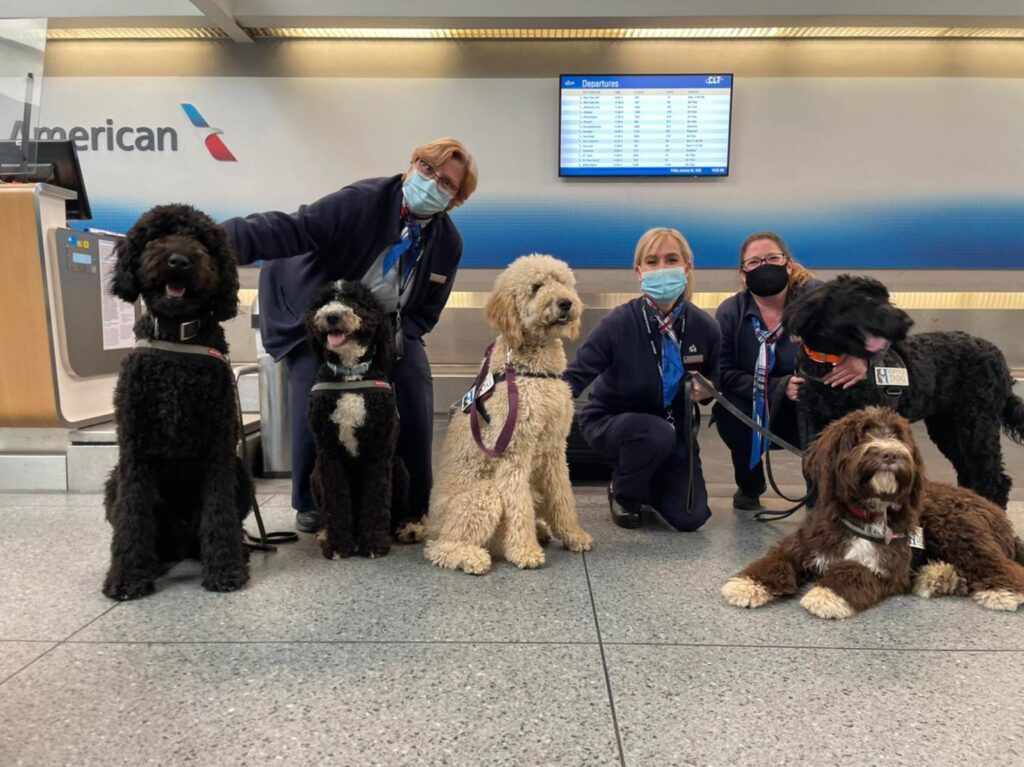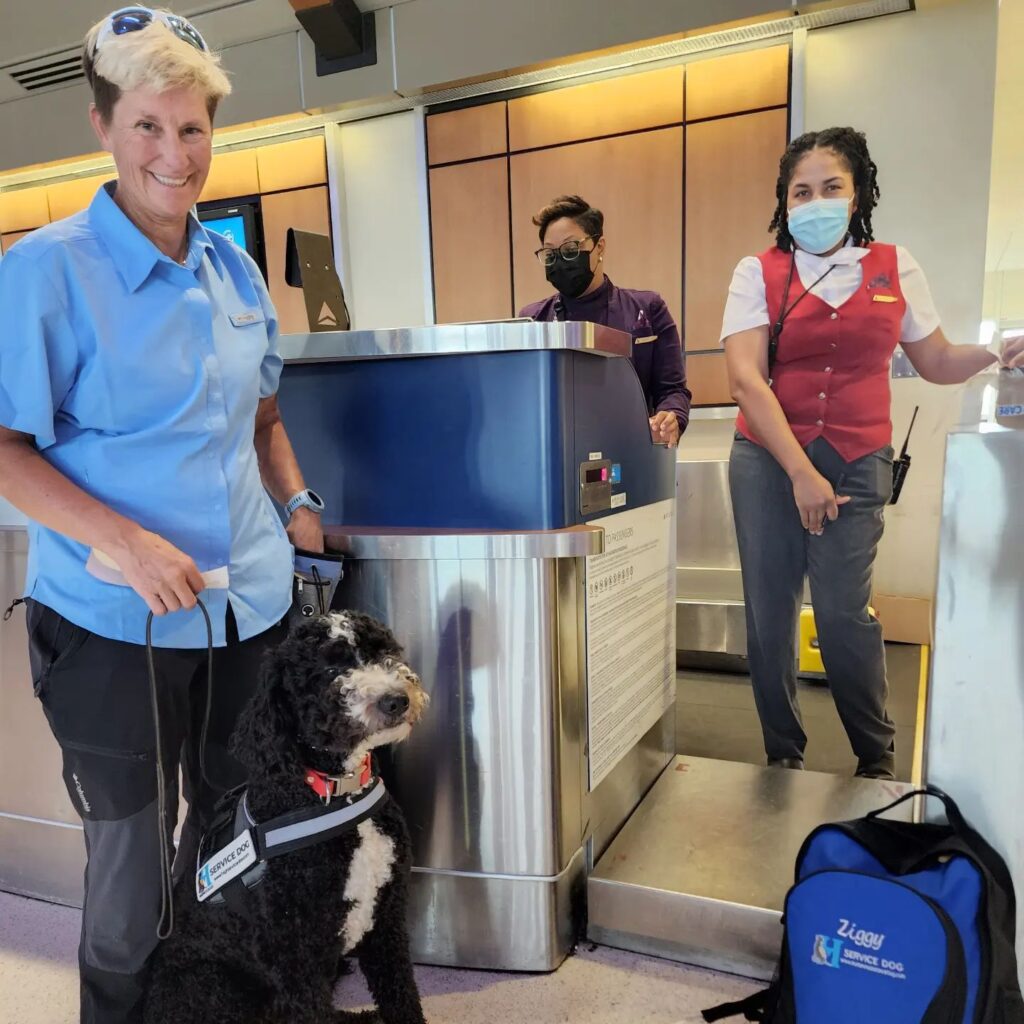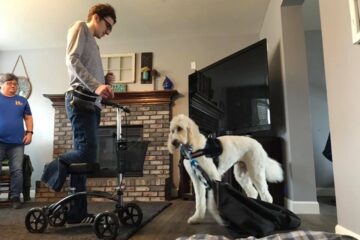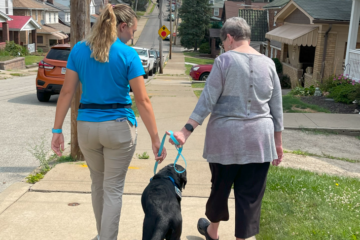Preparing to fly with a service dog requires more than packing extra food and water. Under the Air Carrier Access Act (ACAA), airlines must allow passengers onboard with their service dogs – but there are rules and regulations. If you’re getting ready for your trip and looking for up-to-date information on the laws surrounding service dogs on planes, the details might have changed since you last looked it up.
Only dogs are recognized as service animals under the ACAA, irrespective of breed or type. A service animal is a dog that performs tasks for the benefit of people with physical, mental, sensory, psychiatric, or intellectual disabilities. Before a service dog boards the plane, there are forms to be filled out and questions to answer to the airline.
This article will outline everything you need to know about what federal law says about traveling with a service dog, and help you prepare for the flight. Consider bookmarking this page to create a checklist before you get to the airport to ensure a smooth trip with your service dog!
The difference between service dogs, emotional support animals, and pet dogs
Firstly, let’s outline the difference between service dogs, emotional support animals (ESAs), and pet dogs – and how they are treated from a legal protection perspective where it relates to flying on an airplane.
- Service dogs: Under the ACAA, airlines are required to allow the service dogs of passengers with disabilities to board the plane. A service animal is a dog, regardless of the breed or type, that performs tasks for the benefit of a person with disabilities. You have the right to fly with your service dog, as long as the dog doesn’t violate safety or health requirements, or cause a disruption at the gate or in the cabin.
- Emotional support animals: Emotional support dogs and other animals, such as parrots, guinea pigs, and rabbits, aren’t considered service animals. Although these animals do benefit their owners, they aren’t service animals because they aren’t trained to perform specific tasks. Therefore, the airline can refuse entry to the plane without legal consequences. However, airlines set their own rules, and some allow emotional support animals onboard.
- Pet dogs: You can fly with your pet in the cabin if they meet the airline’s carry-on pets policy, or in the cargo space in a hard-sided carrier. The dog inside the kennel also must be able to sit and turn around comfortably. For larger dogs, the kennels must be hard-sided, and not exceed 100 pounds in total. Since pet dogs aren’t service animals, they must abide by these general rules.
Most airlines require passengers with service dogs to submit forms prior to onboarding the plane. Depending on the flight duration and where you are flying from to the United States, there are different forms to fill out. In some cases, you may need to submit multiple forms.

Which forms should I submit to fly with my service dog?
The first form to submit is the Department of Transportation’s Service Animal Air Transportation Form. This document includes the name of the service animal and its handler, along with information about the dog’s health and training.
An additional form is the Service Animal Relief Attestation Form, which is only for flights that are eight hours or longer. This form is an assurance that the service dog won’t relieve itself (or will do so in a sanitary way).
An airline that requires either one of these DOT forms must provide them to the passengers on their website in an accessible format.
Additionally, if you’re flying back from a country with a high risk of rabies, you will need to get a CDC Dog Import permit. But dogs with a valid US-issued rabies vaccination certificate don’t require this permit.

Why can an airline refuse my service dog entry to the plane?
Airlines can still refuse passengers to fly onboard with their service dogs even if all the paperwork is in order. The typical reasons are as follows.
- Violating safety regulations due to being too large or heavy.
- Service animals generally need to fit in under the seat in front of you due to safety regulations. Small service dogs can sit on your lap, but only if it can be done safely. If the service dog is too large or heavy to fly with you in the cabin, the airline may ask you to rebook the flight with more open seats, buy a ticket for the dog, or transport them as a checked pet.
- Service animals generally need to fit in under the seat in front of you due to safety regulations. Small service dogs can sit on your lap, but only if it can be done safely. If the service dog is too large or heavy to fly with you in the cabin, the airline may ask you to rebook the flight with more open seats, buy a ticket for the dog, or transport them as a checked pet.
- Barking or growling incessantly.
- Unruly behavior; lunging or jumping at people.
What can an airline ask about me/my service dog?
Sometimes, the airline may ask additional questions if they aren’t sure of the animal’s status. The questions are usually along the lines of what tasks the dog performs, what they are trained to do for the passenger, etc. However, note that the airline can’t ask for specifics on the individual’s disability or ask them to prove if your service dog can or cannot do such things.
The airline cannot ask about the breed of the service dog boarding the plane. It can be any dog breed or type that performs service dog duties. However, as outlined above, if the dog is too large or heavy, airlines may refuse to transport your service dog in the cabin due to safety regulations.
Whilst these questions are frustrating, airlines are primarily trying to identify fake service dogs. If you have a genuine service dog, you have nothing to stress about.
Do I need ID/tags/certification to fly with my service dog?
The airlines don’t require passengers to show proof of ID, tags, or certification for the service dog. Remember, it is illegal for anyone to ask you to show papers or proof of your service dog. However, the service dog must be harnessed and tethered at all times, from the moment you check in to leaving the plane. The only document(s) the airline can ask for is the DOT forms.

Tips for flying with a service dog
- Select an appropriate seat to fly with your service dog. Service dogs can’t block the aisle or emergency exits. Passengers with service animals aren’t allowed to sit near the emergency exits.
- Arrive early at the airport as the airline may ask you to present the DOT documents.
- Don’t overfeed your service dog at the airport. Also, consider taking your service dog to service animal relief areas within the confines of the airport building before the flight.
- Make sure you have packed all the necessary equipment, food, and water for your service dog in for the flight’s duration.
- Since airlines may have their own rules about requiring documents or where you can sit with your service dog, give them a call or visit their website to check their service animal policy.
Flying with a service dog is a protected right. Airlines cannot refuse passengers entry to the airplane for flying with their service dogs – even if a service dog may make other passengers or the flight crew uncomfortable.
Service dogs perform vital work, and they deserve a smooth trip without hassle. Preparing before the flight by following the guidance in this article will lead to a less stressful, more enjoyable flight for you as a service dog handler.



0 Comments